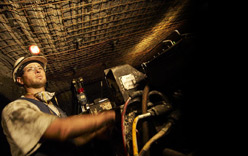LONGWALL MINING
Overview
In the method of secondary extraction known as
longwall mining a relatively long mining face (typically in the range 100 to
300m but may be longer) is created by driving a roadway at right angles between
two roadways that form the sides of the longwall block, with one rib of this
new roadway forming the longwall face. Once the longwall face equipment has
been installed, coal can be extracted along the full length of the face in
slices of a given width (referred to as a "web" of coal). The modern longwall face is supported by
hydraulically powered supports and these supports are progressively moved across
to support the newly extracted face as slices are taken, allowing the section
where the coal had previously been excavated and supported to collapse
(becoming a goaf). This process is repeated continuously, web by web, thus
completely removing a rectangular block of coal, the length of the block
depending on a number of factors (see later notes)
Basic longwall mining principle simplified (retreating longwall in this case)
A coal haulage system is installed across the face, on
modern faces an "armoured face conveyor or AFC". The roadways which form the sides of the
block are referred to as "gate roads". The roadway in which the main panel conveyor is
installed is referred to as the "main gate" (or "maingate"), with the roadway at the opposite end
being referred to as the "tail gate" (or "tailgate") roadway.
The benefits of longwall mining compared to other methods
of pillar extraction are:
-
Permanent supports are
only needed in the first workings portion and during installation and recovery
operations. Other roof supports (longwall chocks or shields on modern longwalls)
are moved and relocated with the face equipment.
-
Resource recovery is
very high - in theory 100% of the block of coal being extracted, though in
practice there is always some coal spillage or leakage off the face haulage
system lost into the goaf, especially if there is a lot of water on the face
-
Longwall mining systems
are capable of producing significant outputs from a single longwall face
– 8 million tones per annum or more.
-
When operating
correctly the coal is mined in a systematic, relatively continuous and
repetitive process which is ideal for strata control and for associated mining
operations
-
Labour costs/tonne
produced are relatively low
Disadvantages are:
- There is a high capital cost for equipment, though probably not as high as first appears when compared
to the number of continuous miner units which would be required to produce the
same output.
- Operations are very concentrated ("all eggs in one basket")
- Longwalls are not very flexible and are "unforgiving" - they do not handle seam discontinuities well;
gate roads have to be driven to high standards or problems will arise; good
face conditions often depend on production being more or less continuous, so
problems which cause delays can compound into major events.
- Because of the unforgiving nature of longwalls, experienced labour is essential for successful
operations.
A major decision to be made is the size of longwall
blocks. Because modern longwalls involve a large number of pieces of equipment
(numbers of a magnitude of several hundred items, with many components weighing
up to 30 tonnes or more), the process of recovering the equipment from a
completed block, transporting it to a new block and then installing it in the
new block (often with much of it being taken out of the mine for overhaul on
the way) is a very major operation. Apart from the direct cost involved,
production and hence income is zero during this period. Bigger longwall blocks
will enable the number of relocations to be minimized, however there are
limiting factors to the size of longwall blocks:
- The longer the face the more power is required on the face coal haulage system (see later notes on
AFC's). The greater the power, the larger the physical size of the drive units
(usually there is a drive unit at both ends of the face). The drive units have
to fit into the excavation and allow room for access past them, for ventilation
across the face and for some degree of roof to floor closure. Also the greater
the power, the larger (and therefore heavier) the chain on the face conveyor
– these chains have to be manhandled on the face at times and there are
practical limitations as to the size of the chain.
- In some longwall installations, the heat created by the high power haulage drives may become a
factor.
- Both face width and length may be governed by limitations created by lease boundaries, seam
discontinuities or variations, already existing mine development and/or
ventilation capacity.
- The ability of the mine to develop new longwall blocks so that longwall production continuity is not
adversely impacted.
- Condition of equipment – changing out some items for overhaul or replacement during the life of
a longwall block can be problematic, and is best done during a relocation.

